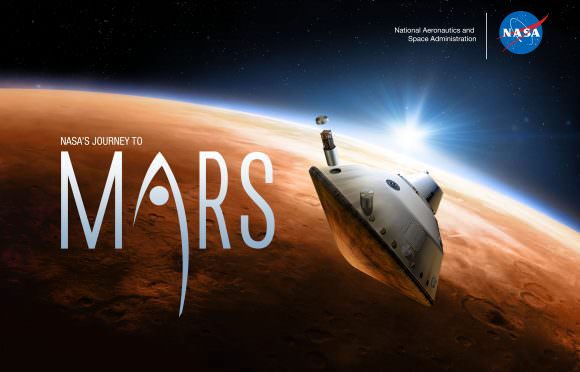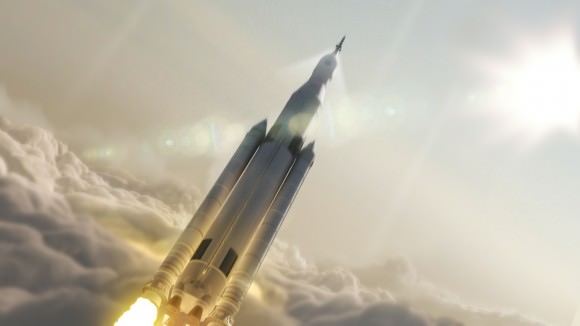It's no secret that NASA has had its share of worries with the Trump administration. In addition to being forced to wait several months to get a sense of the administration's priorities, the space agency has also had to contend with proposed cuts to its Earth Observation and climate monitoring programs. But one thing which does not appear to be threatened is NASA's "Journey to Mars".
In accordance with the National Aeronautics and Space Administration Transition Authorization Act of 2017, the Trump administration has finally committed to funding NASA's plans for deep space human exploration in the coming decades, and to the tune of $19.5 billion. Central to these plans is the proposed crewed mission to Mars, which is scheduled to take place by 2033.
The Act was introduced to Congress back in February and presented to President Trump for approval on Tuesday, March. 9th. Consistent with the Space Administration Authorization Act of 2010 and the NASA Transition Authorization Act of 2016, this bill approved of $19.5 billion in funding for NASA for fiscal year 2017, much of which was earmarked for the continuation of NASA's "Journey to Mars".

NASA has unveiled a new exercise device that will be used by Orion crews to stay healthy on their mission to Mars. Credit: NASA
In addition to maintaining the US government's commitment "to extend humanity's reach into deep space, including cis-lunar space, the Moon, the surface and moons of Mars, and beyond", the Act also expressed the need for a continued commitment to the International Space Station and the utilization of Low Earth Orbit, and other related space ventures.
However, it is Section. 431, Subtitle C - Journey to Mars, that contains all the articles that are of particular interest to space enthusiasts - as these deal with the planned missions to Mars. Article 432, titled "Human Exploration Roadmap", specifically states that:
"The Administrator shall develop a human exploration roadmap, including a critical decision plan, to expand human presence beyond low-Earth orbit to the surface of Mars and beyond, considering potential interim destinations such as cis-lunar space and the moons of Mars.
This roadmap, according to the Act, will include all the science and exploration goals that were outlined in the 2014 report, "Pathways to Exploration: Rationales and Approaches for a U.S. Program of Human Space Exploration", which was prepared by the National Academies of Sciences, Engineering, and Medicine's Committee on Human Spaceflight.

Artist concept of NASA's Space Launch System (SLS) 70-metric-ton configuration launching to space. Credit: NASA/MSFC
In addition, they cite the many plans prepared by NASA and other advocates for Mars exploration over the years. These include "The Global Exploration Roadmap" (2013), "NASA's Journey to Mars - Pioneering Next Steps in Space Exploration" (2015), the JPL's "Minimal Architecture for Human Journeys to Mars" (2015), and Explore Mars' "The Humans to Mars Report 2016".
The Space Launch System (SLS), the Orion Space Capsule, a deep space habitat, and other capabilities are cited as crucial technologies. Other technologies that are identified are "space suits, solar electric propulsion, deep space habitats, environmental control life support systems, Mars lander and ascent vehicle, entry, descent, landing, ascent, Mars surface systems, and in-situ resource utilization."
And last, but not least, is the need to pursue robotic and crewed missions that are intended to test these technologies - aka. Exploration Mission-1 (EM-1) and Exploration Mission-2 (EM-2). The former mission (which is scheduled for launch on September 30th, 2018) will be the first launch of the SLS with the Orion Capsule on-board, and will involve an uncrewed Orion being sent on a translunar mission.
Exploration Mission-2 (which is expected to launch in August of 2021) will be consists of a crew of four astronauts conducting another flight around the Moon and returning to Earth. Other crewed explorations are expected to follow during the 2020s, which may or may not include the crewed exploration of an asteroid towed into lunar orbit (as part of the Asteroid Redirect Mission, or ARM).
Here too, the Act was consistent with the NASA Transition Authorization Act of 2016. Based on growing budget assessments and the judgement that the benefits of "the Asteroid Robotic Redirect Mission have not been demonstrated to Congress to be commensurate with the cost", the Act recommends that NASA select a more "cost-effective" option for testing the Orion capsule.
Aside from testing the components and developing the expertise necessary for a crewed mission to Mars, these mission will also establish an all-important "launch cadence". In other words, NASA hopes to begin conducting regular launches using the SLS between 2021 and 2023, which will be key to restarting crewed exploration of the Solar System.
Of course, the Act also emphasizes the need for continued research into the potential health risks, which are currently being performed aboard the ISS. These include the dangers of exposure to radiation, the long-term effects of time spent in microgravity environments (i.e. muscle degeneration, loss of bone density, organ degeneration, and loss of eyesight), and efforts to mitigate them.
Of course, critics of the Act cite the adjustments made to spending on Earth sciences and heliophysics. In addition, this funding is only for the coming year, and future commitments will need to be made to ensure that the "Journey to Mars" can happen in the time frame provided. But the Act passed with almost unanimous support, and seems to have confirmed what many observers claimed about the space priorities of a Trump administration.
Proponents of space exploration and a mission to Mars can therefore rest easy, as it seems that both are safe for another year. As for Earth science and research, which are intrinsic to helping us predict the effects of climate change, that's another battle!
Further Reading: congress.gov
No comments:
Post a Comment